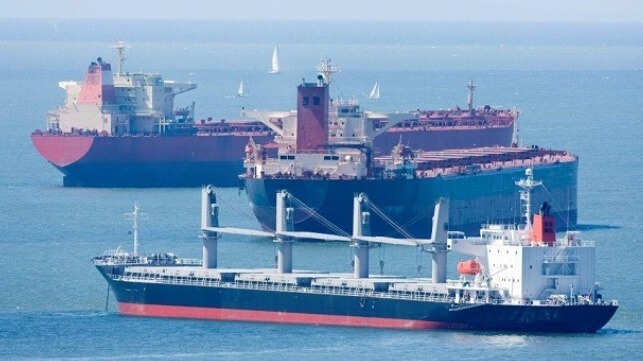Why IMO Needs to Deliver More Ambitious Decarbonization Targets

 As a society, we are increasingly transporting more cargo by sea.[i] And as a result of this increased demand for shipping, greenhouse gas (GHG) emissions have continued to rise.[ii] While the responsibility of tackling climate change lies across every industry, as a large and interconnected part of the global supply chain, shipping has a critical role to play.
As a society, we are increasingly transporting more cargo by sea.[i] And as a result of this increased demand for shipping, greenhouse gas (GHG) emissions have continued to rise.[ii] While the responsibility of tackling climate change lies across every industry, as a large and interconnected part of the global supply chain, shipping has a critical role to play.
But what about the role of industry policy and regulation? Is enough progress being made in this space? And is it happening at the pace needed by the industry?
Undoubtedly, some progress is already taking place – and this should be both recognized and applauded. For one, the International Maritime Organization (IMO) has implemented short-term measures that focus on design and efficiency improvements. Meanwhile, the European Union (EU) has agreed a package of measures that focus on shipping decarbonization; for example, the FuelEU Maritime regulation sets an 80% target for GHG reduction in the energy used onboard ships by 2050, with a gradual, proportional increase being implemented before that date. We’ve also seen the extension of the EU Emissions Trading System to cover EU shipping from 2024, which looks to limit emissions and contribute to the goal of EU states becoming climate neutral by 2050.
At Shell, we welcome the regulatory progress being made. But, to prevent distortions and carbon leakage – and to drive decarbonization at the pace required – we need an ambitious, robust and global policy regime in place as soon as possible. The expectation being that this will include a clear net-zero emissions by 2050 ambition and trajectory. Coupled with policies that support a level playing field and encourage first movers to use renewable fuels, this should contribute to greater production and supply, and in turn, help to establish a clear and global business case for the scale of investment required.
A chance for change
Of course, there is already a general commitment to decarbonization at the IMO, with a regulatory framework for the reduction of GHG emissions by at least 50% come 2050, compared to 2008. But it is widely believed that this needs to be ramped up, with actors from across the value chain holding off on making critical investment decisions without clarity on regulation and the pace they need to follow.
With a revised IMO decarbonization strategy set to be adopted at the Marine Environment Protection Committee (MEPC-80) in July 2023, the sector has a golden opportunity to set a new tone and inject greater urgency into international shipping’s decarbonization.[iii] This should support the expedited delivery of the regulatory framework that is required to drive the implementation. And with more regulatory clarity, the industry should be able to determine the direction and pace of global renewable fuel demand, meaning it can better plan for the critical investments needed.
But for this to happen, we believe the following elements should be included in the strategy review:
1) Clear targets: As an actor wearing multiple hats within shipping – from a marine fuel supplier to charterer – we support a target of net-zero emissions by 2050, based on a Well-to-Wake (WtW) GHG calculation. This should be supported by clear, ambitious and practicable interim targets for 2030 and 2040 to necessitate immediate action.
2) Strong policy levers: In addition to an increase in ambition level, there are several policy levers and measures that are also needed:
• To accelerate progress, we support a 5% reduction target through the use of renewable fuels, based on CO2eq/MJ on a WtW GHG basis in 2030, compared to current fuel use.
• There is also a crucial opportunity for policy mechanisms to address the price gap to alternative fuels, as well as the creation of a fund for climate adaptation.
3) Alternative fuel support: While the availability of renewable fuels of non-biological origin (RFNBO) will be limited in the short term, multipliers could support their initial use and scaling.
4) Energy efficiency incentives: There needs to be further incentives to drive the uptake of energy efficiency measures based on energy use.
The cost of inaction
With these measures in place, there will be a more effective framework for supporting the transition to becoming a lower-carbon industry, with greater clarity on the pathways to get there. But, if the IMO does not provide a strong signal – or even maintains the status quo – the scaling of renewable fuels for shipping could be delayed, and shipping could become responsible for 10-13% of global emissions within just a few decades.[iv] Not only would this risk the industry falling behind the Paris Agreement commitments entirely, but for each year of delay in the start of material emissions reductions, a further $100 billion could be added to the total cost of decarbonizing the sector, according to findings from the UK paper submitted to MEPC-79. [v]
Therefore, we simply have no time to lose. Supply chains for alternative fuels could take up to 10 years to develop at the scale required, while we know that ships built today will still be on the water in 2050. [vi] With this in mind, and to ensure the deployment of low and zero-carbon fuels is not delayed, the IMO must act quickly to get this framework in place.
Keeping the industry on target and on time
It is true that the waters have been turbulent over the past couple of years, with external factors such as the COVID-19 pandemic and the war in Ukraine causing uncertainty within shipping and other hard-to-abate sectors. That said, I am encouraged that our decarbonization journey has continued and that the EU, and more broadly the IMO, have taken steps to reduce the environmental impact of the 1.85 billion metric tons of cargo shipped globally each year.[vii]
However, this is only the first part of the journey. The second part, and beyond, begins in July – with the IMO strategy revision at MEPC-80. There, I strongly hope to see a coherent, unambiguous and decisive way forward. Because only an ambitious, robust and global framework will help create the clear demand signals needed for the energy supply industry to invest and deliver renewable energy sources at the scale required. Any less – or any delay – will mean that shipping may have lost a prime opportunity to unlock the transition to net-zero emissions.
Melissa Williams is President of Shell Marine.
[i] UNCTAD; Clarkson Research Services https://www.statista.com/statistics/267603/capacity-of-container-ships-in-the-global-seaborne-trade/
[ii] IPCC https://www.ipcc.ch/report/sixth-assessment-report-cycle/
[iii] International Maritime Organization. “Revision of the strategy.”
[iv] Anthony King. “Emissions-free sailing is full steam ahead for ocean-going shipping.” European Commission. 06 September, 2022.
[v] MEPC 79/INF.29 (United Kingdom).
[vi] US Department of Energy – Hydrogen Production and Distribution and Biodiesel Production and Distribution., S&P Global Commodity Insights on plant construction timelines (ammonia, biofuels, hydrogen, methanol, LNG)
[vii] UNCTAD; Clarkson Research Services . “International seaborne trade carried by container ships from 1980 to 2020.” Statista. 23 March, 2023.
The opinions expressed herein are the author's and not necessarily those of The Maritime Executive.
